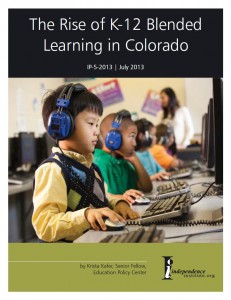IP-5-2013 (July 2013)
Author: Krista Kafer
PDF of full Issue Paper
Scribd version of full Issue Paper
Executive Summary
More than a decade of research and development has produced sophisticated computer-based instruction, curriculum and assessment programs that have transformed online education from the textbook-like classes of yesteryear to the engaging, dynamic learning experiences of today. These online tools combined with face-to-face instruction create what is known as blended learning. Effective integration of technology can reduce the amount of time teachers spend on tasks like attendance, grading, data aggregation and analysis, and skills practice, thereby enabling teachers to focus on high-impact instructional strategies and personalized attention. A well-designed blended learning program can even save schools money because computer-based instruction requires fewer on-site teachers and less classroom space.
The Clayton Christensen Institute for Disruptive Innovation has identified four blended learning models:
- Model 1 Rotation: Students alternate between face-to-face instruction and online lesson delivery in a classroom, computer lab or at home.
- Model 2 Flex: The curriculum is delivered online usually in a learning lab while teachers provide on-site support in the form of tutoring or small group instruction.
- Model 3 Self-blend: Students take traditional courses at school and self-selected online courses at home.
- Model 4 Enriched Virtual: Students take classes online at home and check in with teachers for face-to-face learning as needed.
Colorado is well positioned to implement and test blended learning programs on a larger scale. The state has abundant experience with online education, several non-profit blended learning support organizations, and philanthropic and government backing. Several Colorado districts have invested in online courses, professional development for online and traditional classroom teachers, and state-of-the-art learning centers to better enable students to participate in online and blended learning classes. Charter and district public schools have begun to implement blended learning models and have seen promising results.
In order to facilitate the development of blended learning, lawmakers should consider policy changes that 1) enable per-pupil revenue to flow directly to schools and courses rather than first through the district central office; 2) distribute funds based on multiple count dates rather the current single October 1 enrollment count, using average daily membership (ADM) rather than attendance; 3) divide payments to online course providers so that 50 percent of the funding is provided after successful completion; and 4) commission experimental or quasi-experimental research into the impact of blended learning on student proficiency in reading and math on state assessments.








